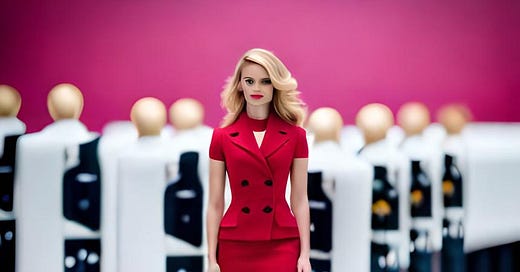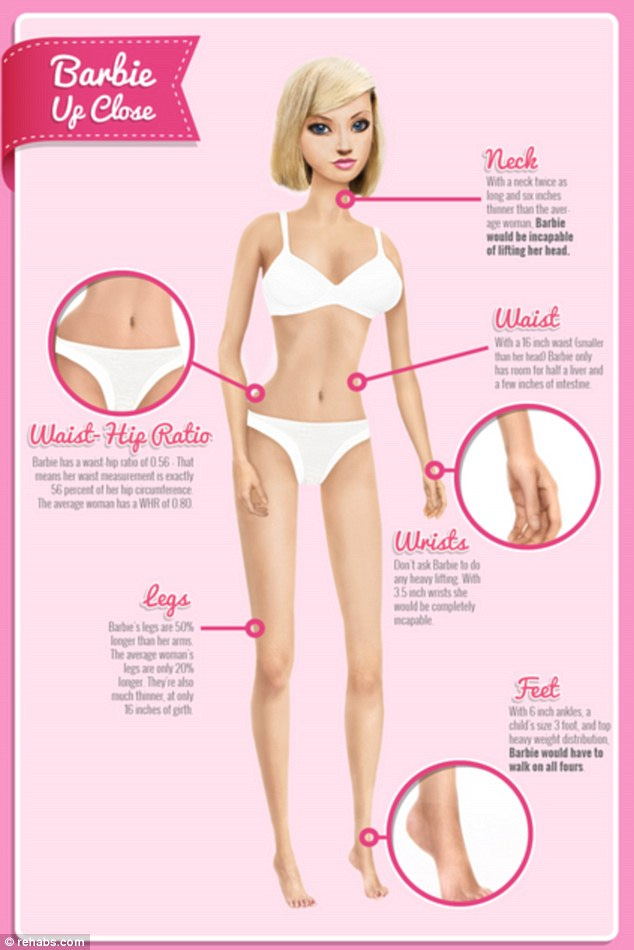Arguably there’s nothing that hasn’t already been said about Barbie the movie, as every publication is churning out thought-pieces while every girl, guy and other dons pink and the world axis tilts a bit with cinema attendance/social media posts—and yet: everything is left to be said about Barbie.
Barbie, the stretched Jill-of-all-trades doll behind all this taffy-colored media frenzy, can be whatever you want her to be, so the perspectives on her are essentially unlimited. Which of course opens up a little wormhole in the universe where I too can insert my own ideas about Barbie—movie unseen.
I have no theater budget and my daughters are perhaps the only girls in the Western hemisphere who don’t give a plastic poo about this cultural mandate, so I will sit tight and see it when it eventually hits one of the streaming platforms. I’m also constitutionally averse to jumping in the same convertible everyone else is riding at the same exact moment, though I will admit I’m super-excited about this movie in a way that I haven’t been about any in ages, especially the more I hear how it’s so decidedly female-forward.
M.G. Lord, the author of Forever Barbie: The Unauthorized Biography of a Real Doll, was a guest Thursday morning discussing Barbie and feminism on NPR:
While Lord says the new movie is “incredibly feminist,” she hesitates to apply that word to Barbie herself. Instead, she sees the doll as its own sort of Rorschach test.
“People who hate Barbie for one reason or another, one might say that they project their fears and prejudices onto the doll. And people who irrationally adore this hunk of plastic are also puzzling to me,” Lord says. “I think that may be the secret to why she’s endured so long: That she weathers the projections and the conflicting projections of so many people.”
So let’s project.
My first Barbie was not a Barbie at all, but one of those hollow facsimiles sold at something like our local Woolworth’s five-and-dime store in Bristol, CT back in the day. It only had some hair plugs which flew up revealing a mostly bald head under that frontal flap, and I believe it came with one lame poly dress. I got this for perhaps my sixth or seventh birthday from one of three kids invited to my tiny first (and last?) “friend” party, and yet, I was still pretty thrilled to receive this gateway-drug doll.
I’m pretty sure this piece of trash only opened up for me the desire to transition to a “real” Barbie, which I certainly gazed at longingly through the display plastic on any trip to the pink aisle of a toy store. I accumulated all of maybe two real Barbies over the following years before a Ken came along—and only for one-night stands.
In my playland utopia of a red-carpeted basement, Barbie embodied all kinds of role-playing potential as she tangentially performed whatever job she was doing (anything at all but only superficially!), while for me, the real value in this was the architect I became on her behalf, the fashion designer, the script writer. My parents weren’t going to buy me any Barbie Dream Houses, so I created my own, covering the carpet with a sprawling one-level, open-style mansion with an impressive collection of big wooden blocks and boards. I would even use my dad’s drafting table to sketch out housing plans and furniture arrangements with all the rulers and stencil shapes he had. And with a limited clothing budget (and Barbie clothes could be such crap), I remember taking thin white human anklet socks topped with lace and poking sleeve holes in them—utilizing whatever I could find lying around, which was a lot. (See: Hoarders).
Then some serious motivation to further decorate and accessorize came when a rare Ken surfaced via my friend Brigit. Brigit, although a few years younger than me, knew way more than I did about what a man and a woman might even do on a “date.” She had unlimited Cable channels at her house, even the newly launched MTV network, so she saw things. When Ken came around, Barbie was bumping up against him—lack of viable organs be damned—on a horizontal block bed. I had no idea what this meant, but we were now able to play out these half-hatched ideas of romance and womanhood. And then Ken would retreat to Brigit’s house and I’d be solitary with my girl-dolls again. Did this insertion of another gender change the game for the worst? Probably. We would hit an age soon enough that I call the Death of Girlhood, where we become self-conscious and boy-aware. Suddenly my astigmatism glasses and intelligence were embarrassing, my legs hairy, and I was shy rather than my former magical. And Barbie comes to represent something we’d never physically be but should aspire to.
If I did enough “I must I must I must increase my bust” like Judy Blume’s Margaret, I too could have such overt breasts. If I ate ice (like I did one high school summer solely spent suntanning), I too could achieve such a tapered waist, or more likely: an eating disorder.
Have you seen how odd it is to impose the proportions of Barbie onto a real woman? Sadly, nowadays this abstract woman has become so much more real thanks to unlimited surgery options and the curse of the Kardashians.
From the Barbie fact sheet, sourced from Body Wars by Margo Maine, Ph.D. (Gurze Books, 2000):
If Barbie were an actual women, she would be 5’9” tall, have a 39” bust, an 16” waist, 33” hips and a size 3 shoe!
Barbie calls this a “full figure” and likes her weight at 110 lbs.
At 5’9” tall and weighing 110 lbs, Barbie would have a BMI of 16.24 and fit the weight criteria for anorexia. She likely would not menstruate.
If Barbie was a real woman, she’d have to walk on all fours due to her proportions.
This article in the Daily Mail dissects this further, analyzing the infographics from Rehabs.com: with these proportions, Barbie can’t lift her head on such a thin neck; with such a tiny waist there’s only room for half a liver and a few inches of intestines; she can’t carry anything with those little wrists; her weak ankles and lilliputian feet can’t support her.
“Feminist movie” kudos aside, there’s still the reality that Margot Robbie is impossibly perfect and is inevitably the face of what girls will aspire to be, more than President or Astronaut or whomever, but the “star” herself. According to YouTuber Lorrie Hill, plastic surgery aficionado who analyzes the work done by celebrities, the incision, implantation, fat removal, and injection cost of achieving Robbie’s “natural beauty” through the years is estimated at $152,500.
Interesting that we call it “plastic” surgery, by the way, and human attempts at “achieving Barbie” have littered our media landscape and skewed our body dismorphia most notably since surgery addict Jenny Lee appeared on Oprah in 2004. Lee’s addiction now seems quaint compared to what we’ve become used to seeing.
Imagine a world where women rule, and men are just accessories,
wrote a friend’s friend about the movie on Facebook.
Or, imagine a Barbie that Amy Schumer (surely more of a realistically-bodied Skipper doll) got to star in, and a real world that might embrace that.
More from the NPR piece:
The movie takes place largely in Barbieland, a candy-colored, women-centered utopia where Barbies hold the positions of power (all of the jobs, really, except for “beach”) and Kens are essentially peripheral. That’s painted in stark contrast to the “real world,” of course.
Of course. The fact that this movie—co-written, directed and partially produced by talented women and showcasing Women World in all its shiny glory—can fire up all these female viewers of all ages with such positive energy is outstanding, but does this good energy move the needle on anything measurable beyond commerce, unknown. It remains an absolute candy-coated fantasy as most of us continue to report to work where a man sits atop the pyramid and our gender clearly hasn’t won all that we might have imagined in 1959 (when Barbie was born) that we would have won by now.
But I can say that Ken, at least romantically, is peripheral for me as a divorced mom, as is Barbie. My body image has emerged intact from the sludge of adolescence and young adulthood to a midlife state of comfort in my skin and ultimate health. I can be proud of the work I do—how I help people for a living and have always found ways to produce creatively no matter what. I have a boyfriend-at-large—we live two hours apart which hurts and helps us in various ways, but definitely leaves me plenty of space and time for important pursuits like writing this newsletter and raising these Barbie-ambivalent daughters.







Thought it was great. I have some minor quibbles but they don't register against how creative and smart and fun it was. Also, pink. Very pink. Crazy pink in a theater. Margot Robbie is great. Been a huge fan since "I Tanya," and the next two times I saw her on the screen I didn't realize they were all the same woman. Also (thank God) they allow some complexity and pathos toward men through Ken so it's not a "Men bad/Women good" movie at all. The whole thing's pretty subversive, really. Which is fun! And pink!
The Barbie movie is such a fascinating cultural study. I had little idea that perceptions of Barbie were this contentious, growing up only hearing the negative-stereotype aspect, and being acutely aware of how damaging that was, especially as I embraced a punk rock lifestyle for a few years.
On the other hand, my partner (Alley) grew up playing with Barbie dolls, but she kind of tore their bodies apart, so... yeah, these toys meant very different things to different people.
Go figure: I played martial arts with my own GI Joes.